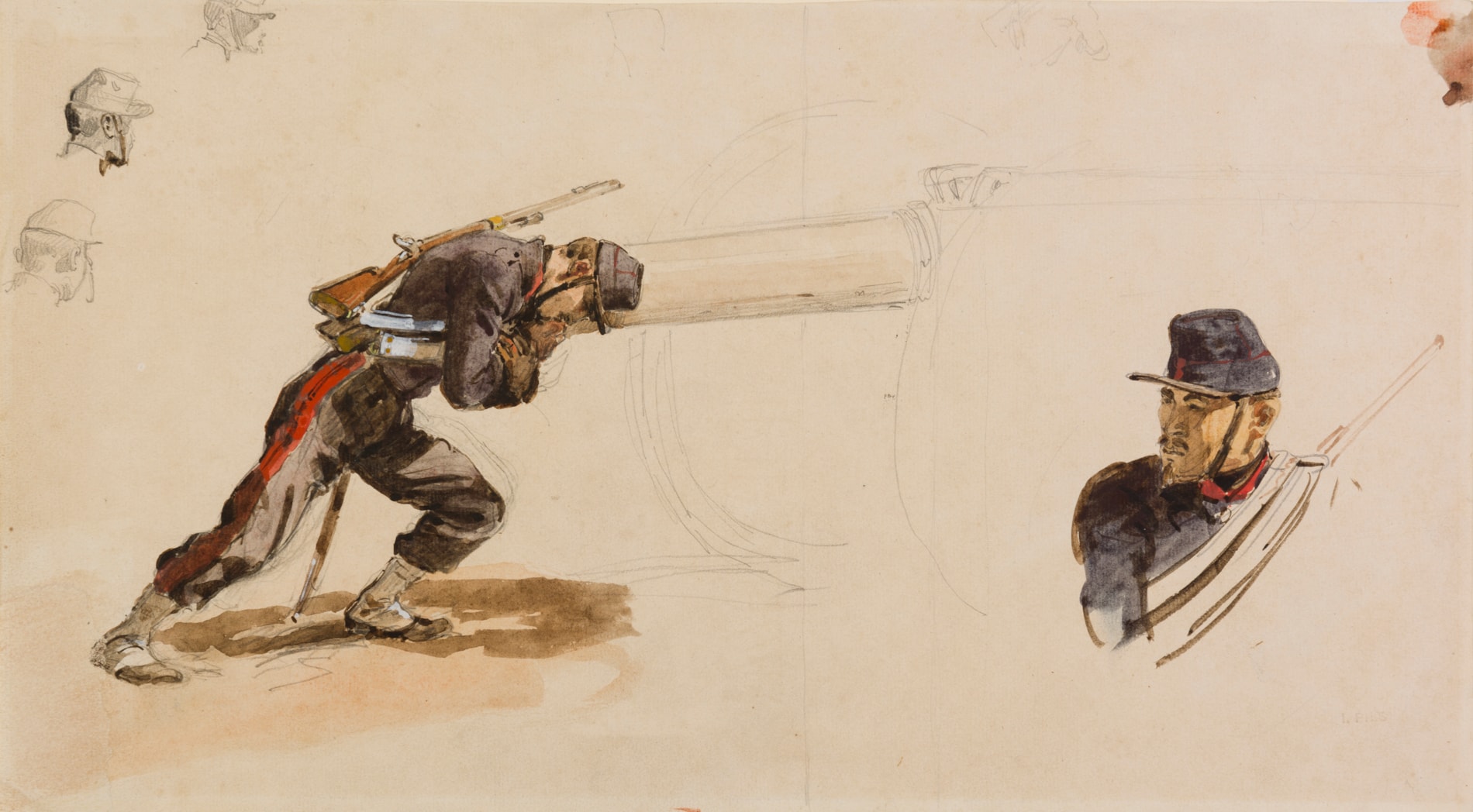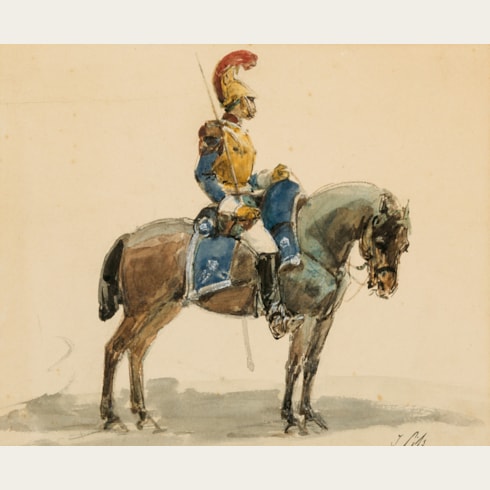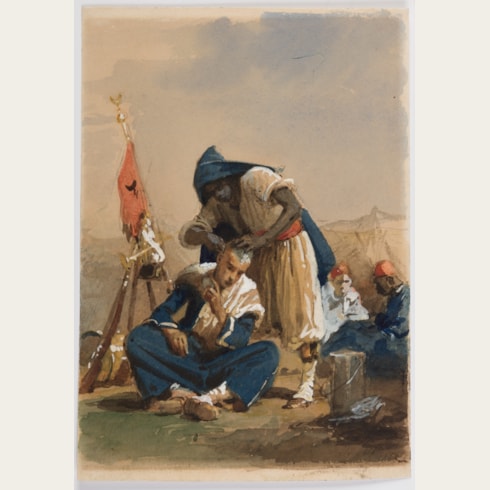Isidore PILS
(Paris 1813 - Douarnenez 1875)
A Soldier Pushing a Cannon, and other Studies of Soldiers
Sold
Watercolour, heightened with touches of gouache, over a pencil underdrawing.
A made-up area near the lower left corner.
Stamped with the atelier stamp I. PILS (Lugt 2030) at the lower right.
240 x 430 mm. (9 1/2 x 16 7/8 in.)
A made-up area near the lower left corner.
Stamped with the atelier stamp I. PILS (Lugt 2030) at the lower right.
240 x 430 mm. (9 1/2 x 16 7/8 in.)
This drawing may be an early preparatory study for Isidore Pils’s large Crimean War painting of The Passage of the River Alma by the Division of General Bosquet, 20th September 1854, completed in 1861 and today in the Château of Versailles. Although none of the figures in this watercolour seem to appear precisely in the finished painting, there are significant similarities between the soldiers pushing the cannon in the large canvas and those seen in the present sheet.
Pils worked for four years on the massive painting of The Passage of the River Alma, which measured five metres by nine metres, and earned 20,000 francs for the commission. Intended for a room known as the Salle de Crimée at Versailles, the painting depicts a significant episode during the Battle of the Alma River. General Pierre Bosquet’s 2nd Division of the French army, led by colonial troops known as Zouaves, arrived at the mouth of the Alma River, where there were steep cliffs rising fifty metres high on the opposite bank. The defending Russian forces of the Moscow Regiment, believing the cliffs to be impregnable, did not defend their side of the river with artillery. The leading units of Zouave infantry swam across the river and scaled the cliffs, and upon reaching the plateau at the top engaged the Russian troops. They managed to hold the position until reinforcements arrived, including other soldiers who hauled twelve cannons up a ravine.
Pils worked for four years on the massive painting of The Passage of the River Alma, which measured five metres by nine metres, and earned 20,000 francs for the commission. Intended for a room known as the Salle de Crimée at Versailles, the painting depicts a significant episode during the Battle of the Alma River. General Pierre Bosquet’s 2nd Division of the French army, led by colonial troops known as Zouaves, arrived at the mouth of the Alma River, where there were steep cliffs rising fifty metres high on the opposite bank. The defending Russian forces of the Moscow Regiment, believing the cliffs to be impregnable, did not defend their side of the river with artillery. The leading units of Zouave infantry swam across the river and scaled the cliffs, and upon reaching the plateau at the top engaged the Russian troops. They managed to hold the position until reinforcements arrived, including other soldiers who hauled twelve cannons up a ravine.
Born into a family of artists, Isidore-Alexandre-Augustin Pils was a student of François-Edouard Picot at the Ecole des Beaux-Arts. He won the Prix de Rome in 1838 and spent the next five years in Italy, until 1844. The early part of his career was taken up with mostly religious subjects, although he began to paint military scenes after the Crimean war, in which he acted as an observer. His success as a military painter led to further commissions, including a number of paintings for Napoleon III. One of the artist’s most important paintings, Soldiers Distributing Bread and Soup to the Poor, was commissioned by the State for the sum of 4,000 francs and was exhibited at the Salon of 1852. (The painting has since been lost, and is known only through a lithographic reproduction.) In 1857 a large canvas of a major Crimean episode, The Passage of the River Alma, was commissioned for Versailles.
Pils was also interested in scenes from modern history, exemplified by his famous painting of Rouget de Lisle Singing the 'Marseillaise', exhibited to popular acclaim at the Salon of 1849. Pils also executed a number of paintings for Parisian churches - notably the decoration of the chapel of Saint André in the church of Saint Eustache, painted between 1849 and 1852 and still in situ - and took part in the mural decoration of the Opéra. In 1864 he was appointed a Professor at the École des Beaux-Arts, and made several watercolours of life in Paris during the Prussian siege of the city in 1871.
Pils made numerous drawings, watercolours and oil sketches in preparation for each of his paintings, and particularly for individual figures within the composition. He made his first watercolours of military subjects in the early 1850s, when he began to make studies of soldiers encamped at Vincennes, near Paris.
Pils was also interested in scenes from modern history, exemplified by his famous painting of Rouget de Lisle Singing the 'Marseillaise', exhibited to popular acclaim at the Salon of 1849. Pils also executed a number of paintings for Parisian churches - notably the decoration of the chapel of Saint André in the church of Saint Eustache, painted between 1849 and 1852 and still in situ - and took part in the mural decoration of the Opéra. In 1864 he was appointed a Professor at the École des Beaux-Arts, and made several watercolours of life in Paris during the Prussian siege of the city in 1871.
Pils made numerous drawings, watercolours and oil sketches in preparation for each of his paintings, and particularly for individual figures within the composition. He made his first watercolours of military subjects in the early 1850s, when he began to make studies of soldiers encamped at Vincennes, near Paris.
Provenance
The vente Isidore Pils, Hôtel Drouot, 20 March-1 April 1876
Yvonne Tan Bunzl, London, in 2003.
Yvonne Tan Bunzl, London, in 2003.
Literature
London, Yvonne Tan Bunzl, Master Drawings, 2003, unpaginated, no.20.








